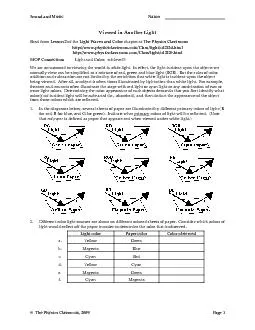/


ed green and blue spotlights 4 Name possible colors that a yellow shirt could appear when viewed under various combinations of red green and blue spotlights 5 Name possible colors that a magen ID: 213039
Download Pdf The PPT/PDF document "Read from Lesson 2 of the Light Waves an..." is the property of its rightful owner. Permission is granted to download and print the materials on this web site for personal, non-commercial use only, and to display it on your personal computer provided you do not modify the materials and that you retain all copyright notices contained in the materials. By downloading content from our website, you accept the terms of this agreement.
Read from Lesson 2 of the Light Waves and Color chapter at The Physics Classroom: http://www.physicsclassroom.com/Class/light/u12l2d.html http://www.physicsclassroom.com/Class/light/u12l2e.html MOP Connection: Light and Color: sublevel 5 We are accustomed to viewing the world in white light. In effect, the light incident upon the objects we normally view can be simplified as a mixture of red, green and blue light (RGB). But the rules of color addition and subtraction are not limited by the restriction that white light is incident upon the object being viewed. After all, an object is often times illuminated by light other than white light. For example, theaters and concerts often illuminate the stage with red light or cyan light or any combination of two or more light colors. Determining the color appearance of such objects demands that you first identify what color(s) of incident light will be subtracted (i.e., absorbed), and then deduct the appearance of the object from those colors which are reflected. 1. In the diagrams below, several sheets of paper are illuminated by different primary colors of light (R ed, green and blue spotlights. 4. Name possible colors that a yellow shirt could appear when viewed under various combinations of red, green and blue spotlights. 5. Name possible colors that a magenta shirt could appear when viewed under various combinations of red, green and blue spotlights. 6. Name possible colors that a cyan shirt could appear when viewed under various combinations of red, green and blue spotlights. Three colo are ON D Spotlights whi